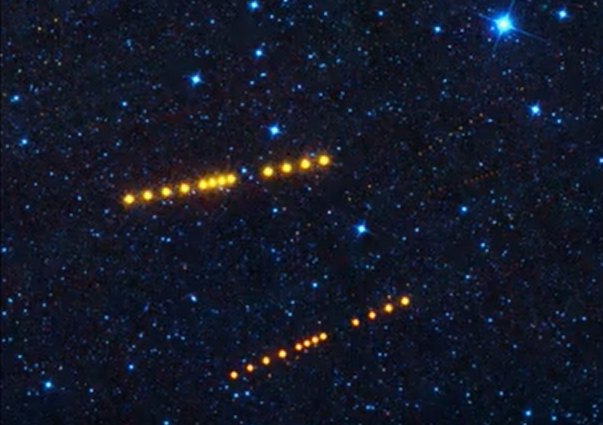
NASA shared a picture of major asteroids Klotho and Lina forming a string of orange dots. Both are found in the asteroid belt between Mars and Jupiter. The space agency tracked the movements of the asteroids and recorded that Lina is 37 miles or 60 kilometers in diameter and it takes more than 2,000 days to orbit the Sun. Meanwhile, Klotho is a bit larger than Lina, it has a diameter of more than 50.9 miles or 82 kilometers and it takes 1,596 days to complete a full trip around the Sun.
Asteroid alert
NASA tracked the objects using the NEOWISE telescope and stated on the website the objects are appearing as strings of orange dots, and the brightest dots belong to asteroids Lina and Klotho. Both asteroids orbit out in the main asteroid belt between Mars and Jupiter, while the smaller asteroids were more distant.
The NEOWISE telescope harvests measurements of asteroids and comets from the WISE images and it provides a rich and crisps archive for solar system objects. The asteroids within the asteroid belt pose little danger to Earth, and that is because of the role that Jupiter plays in the solar system.
Jupiter has a strong gravitational pull that helps to keep the asteroid belt, which is located between Mars and Jupiter, in place so that space rocks are not flying around the solar system. There are also theories that the planet draws loose asteroids, meteors, and comets in.
NASA has stated on its website that astronomers think that if it were not for the giant planet Jupiter exerting its gravitational force on the asteroids in the belt, the inner planets would be bombarded constantly by massive asteroids. The presence of Jupiter actually protects Mercury, Venus, Earth, and Mars from asteroid collisions.
Will asteroids hit Earth?
According to NASA, the chances of a major asteroid hitting Earth is very small, and the space agency believes that there is a one in every 300,000 chance every year that a space rock which could cause regional damage will hit, but the prospect, even if it is devastating, is still possible.
When an asteroid does hit Earth, it could wipe out humanity. Physicist Rob van den Berg wrote on Quora that small asteroids are harmless if they hit Earth, they usually evaporate in the atmosphere before they even reach the ground. If a small asteroid does hit the ground, they do not do that much damage. All that people will be doing is to repair their shattered windows and it is extremely unlikely to get hit by one.
The asteroids that wiped out the dinosaurs thousands of years ago had a size of about 10 miles and the same impact only happens every several million years. No matter how small the chance of an asteroid hitting the Earth now, it is destined that another massive one will eventually hit Earth again in the future.
The asteroids that are capable of causing a massive disaster if they hit Earth are very rare. They would need to be about a kilometer or more in diameter. Such asteroids impact the Earth only once every 100,000 years on average. Other objects of a similar size, like comets, impact Earth less frequently, around once every 500,000 years.
Related article: Due to Global Lockdown, Earth's Ozone Layer is Now Recovering
© 2025 HNGN, All rights reserved. Do not reproduce without permission.








